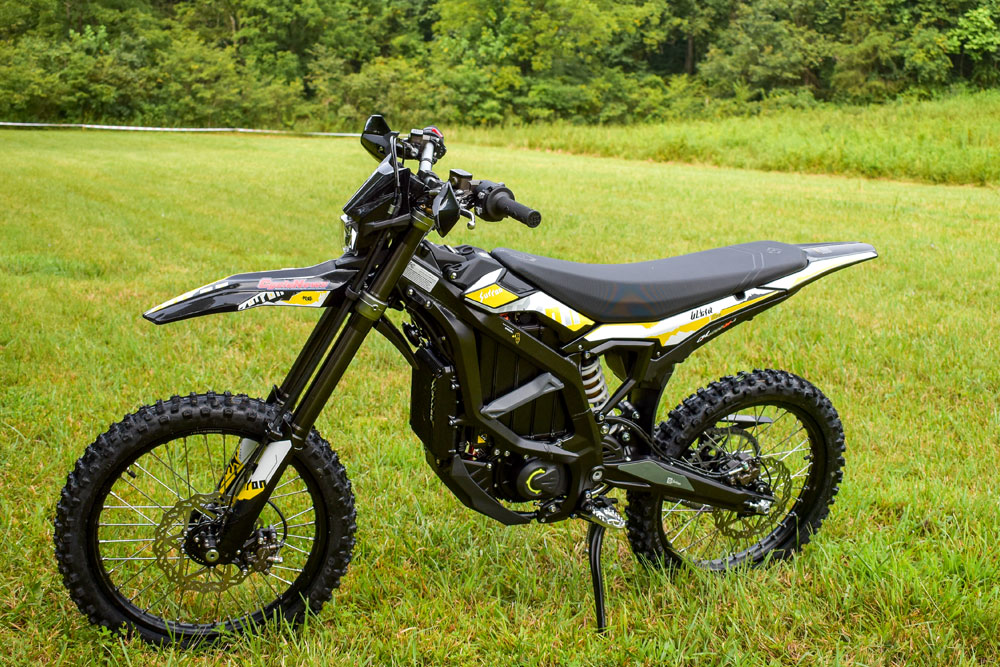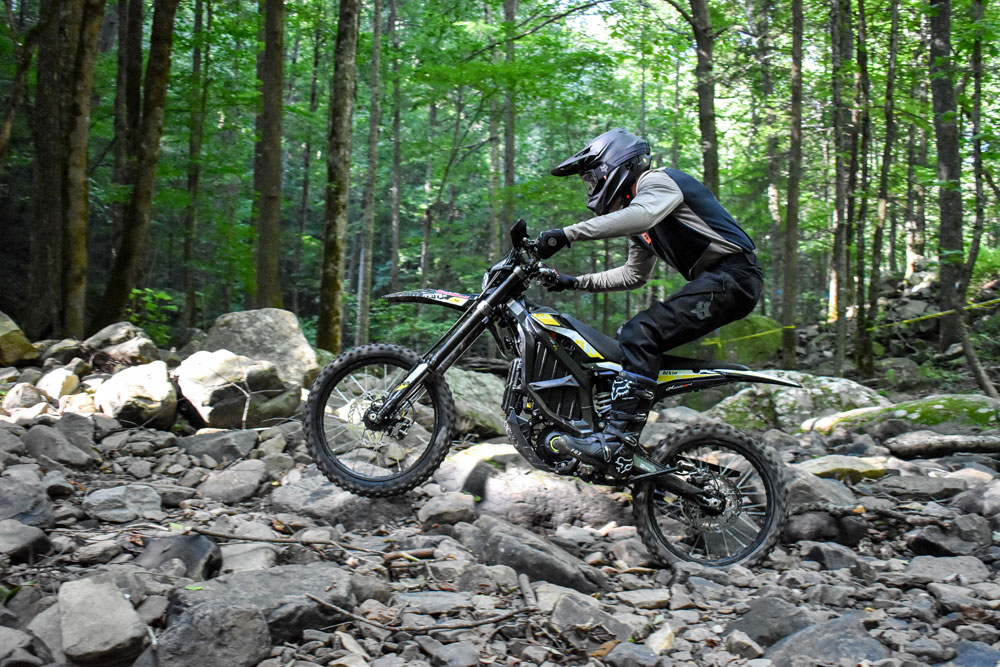Uncategorized
2023 Surron Ultra Bee Review
2023 Surron Ultra Bee Review
The Surron Ultra Bee electric motorcycle includes many features that you may expect on a high-end ADV bike, not a $6500 “entry-level” dirt bike. You have three engine performance maps, adjustable traction control, adjustable braking and coasting battery regeneration modes, adjustable throttle sensitivity, and even reverse—that is a lot of tech. Most importantly, though, on the trail, the Ultra Bee is competent and fun, even for experienced riders.

Photography by Sean Finley
If you are not yet familiar with Surron, the Chinese company has created a cultlike following worldwide for their Light Bee electric motorcycle, which was introduced in 2018 and is comparable to pit bikes. They have a few major upsides over internal combustion pit bikes; they are comparatively quieter and easier to work on with no air filters or oil to change and no fuel needed. So teenagers and teenagers at heart can quietly ride them in backyards and other open areas that would not be acceptable with more noise. We did a test on a Surron Light Bee X and you read it HERE.
Surron released the full-size Storm Bee for 2023 that we also tested, and that bike includes a lot of high-tech features and decent performance but with a weight of about 280 pounds, it puts it more in line with the heavy four-stroke play bike category (think Suzuki DR-Z400).
So, what is the Ultra Bee? It is the Goldilocks Surron. Not too small and not too big. Possibly most notably, it weighs just 187 pounds, about 58 pounds less than a ready-to-ride 300cc two-stroke off-road motorcycle or 70-plus pounds less than an entry-level off-road bike. Some of that weight savings comes from a slightly smaller overall size. The seat height is 35.8 inches, about two inches less than most full-size off-road motorcycles. The wheelbase is 54.3 inches, about four inches less than most full-size off-road motorcycles. The oddly sized 19-inch front wheel rather than a traditional 21-inch wheel combined with a 19-inch rear wheel shod with relatively small 80/100-19 front and 90/90-19 rear tires also contribute to the light weight.

As for power, the Ultra Bee uses Surron’s fourth-generation permanent magnet synchronous motor with 12.5 kilowatts of power (equivalent to approximately 16.8 horsepower) and 325 lb-ft of torque. It has a 74V/55Ah lithium-ion battery, and it takes about four hours to charge from 0 to 100 percent. The Ultra Bee has a top speed of 56 mph and a claimed 87 miles of range (depending on riding conditions, of course).
Although the Ultra Bee is not sold as a street-legal motorcycle in the U.S., it comes with most of the standard items found on a dual-sport bike, including a headlight, brake light and license-plate holder. It also includes a dash that displays the speed, distance and all the various power, traction control and ABS settings, as well as the battery level. Under the seat, where the air filter would typically be, there is a storage area large enough to transport the charger or other items.

How capable and how fun is the Ultra Bee?
We put the Ultra Bee to the test during several days of riding at the Trials Training Center in Tennessee. We were helping lay out the 2023 Red Bull Tennessee Knockout (TKO) Hard Enduro course and used the bike to get around, mark the course and test-run the entire 11-mile amateur race loop. The terrain includes everything from access roads to some of the gnarliest hard-enduro rock sections and hill climbs you can imagine. Rain early in the week added to the difficulty of the terrain. Ninety-six percent of the 500-plus TKO racers chose 300cc two-strokes for this AMA Grand Championship of Extreme Off-Road course. And for the second year in a row, the TKO included an electric bike class with nearly 50 participants taking on the course, including Cycle News co-owner Jesse Ziegler, who swapped out the wheels and tires and raced our Ultra Bee test bike to a sixth-place finish.
Via the bike’s manual, we figured out how to use the various power, traction control, power regeneration and throttle-sensitivity settings. We knew that would be useful in the slippery and challenging sections. The complexity of button combos necessary for some of those changes takes a while to get the hang of, but the most used items (power and traction control) are easy to remember.

A few laps around the grass track felt comfortable, so we headed out onto the trails, and we were impressed right away with the performance. We had a traditional gas bike for back-to-back comparison, and the two bikes were surprisingly equal in capability; the Ultra Bee can get through the difficult stuff easier since you don’t need to worry about being in the right gear, using the clutch, or stalling the bike. The lightweight, two-inch-lower seat height and four-inch-shorter wheelbase are a considerable benefit in rugged terrain and add to your confidence. The only thing that held back the Ultra Bee was the small rear tire losing traction.
The claimed 16.8 horsepower is a lot less than the 50-plus horses available with a modern off-road bike, but the 325 foot-pounds of torque is significantly more, and that torque is what you really notice. We found that in the slick conditions at the Trials Training Center, the Sport power setting with the lowest level of traction control was the hot setup. The tire broke loose too easily with no TC activated, and the higher levels of TC kicked in too early for aggressive riding and hill climbs, but that would be an excellent feature for less experienced riders who don’t want the bike to break traction too easily.

The suspension performs great on relatively slow-speed technical terrain, and it definitely outperforms the suspension found on most trail bikes, but with roughly 9.5 inches of travel in the front/rear, it is not up to the level of a high-performance off-road bike with nearly 12 inches of travel. But for a play bike that costs about 40 percent less than those bikes, you must give up some performance somewhere.
The 240-millimeter front/rear hydraulic disc brakes performed really well. Some of the gnarly downhill sections of the TKO course made them squeal a little, but they never faded. One notable point on the brakes is that the rear brake is activated via a hand lever on the left-hand side of the handlebars, where the clutch lever would typically be. This is common with most electric bikes, and while it takes a little getting used to, not needing to use a foot brake or shifter allows you to focus on weighting the footpegs for traction and balance. And for newer riders, no brake pedal and or shift lever makes riding much easier.
The reverse option proved to be really helpful on the Ultra Bee. If you find yourself stuck, it is sometimes easier to let off the throttle and push the reverse button on the left side of the handlebar to get the bike into a better position than lifting it. This is a cool feature you didn’t even know you would want until you tried it.

As for the range, we could ride for over three hours in the mostly difficult terrain while “play riding.” When Jesse raced it on the 11-mile TKO Saturday Amateur loop, it took nearly one hour, and he had 40 percent of the battery remaining. He made the top 10 to race the ECR eMoto final on Sunday’s 12-mile-long pro loop, and it took one hour and 48 minutes, and he still had 25 percent of the battery remaining. We never started from 0 percent charge, and it took one to three hours to recharge the battery with the standard 110-volt charger. Surron claims it takes four hours to charge from 0 percent to 100 percent, and that is about right from our experience.
During aggressive riding, especially racing, we found it easy to inadvertently hit the power level switch and change the power setting. It was also easy to hit the kill switch and turn the bike off. Both were annoying, and it would be nice to move the placement of those buttons.
The bike proved extremely durable as we abused it on the challenging trails for several days of riding and then three rounds of racing. We had a similar experience with the Surron Light Bee, which we have spent much time on over the last year. They are solidly built with good components and hardware. The high-quality aluminum handlebars and handguards are good examples of this.

